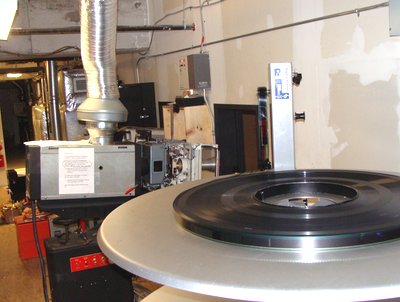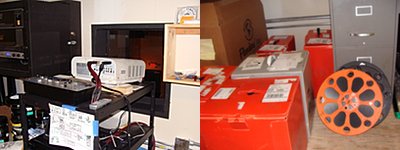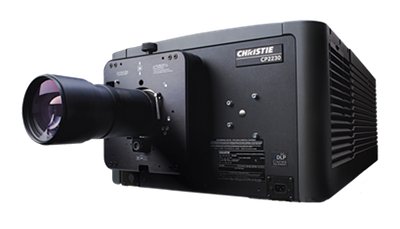- By Dan Veaner
- Around Town
 Print
Print  In an era in which multiplex movie houses often have 20 or more screens, it is remarkable that Ithaca sustains a five-screen art house cinema. But as much as art houses are about independent film making and nostalgia, they are facing the same challenges of rapidly changing technology as commercial cineplexes. That means enormous up-front expenses in re-equipping their theaters with modern digital projectors.
In an era in which multiplex movie houses often have 20 or more screens, it is remarkable that Ithaca sustains a five-screen art house cinema. But as much as art houses are about independent film making and nostalgia, they are facing the same challenges of rapidly changing technology as commercial cineplexes. That means enormous up-front expenses in re-equipping their theaters with modern digital projectors. "For the foreseeable future 35 millimeter will be available, so we're not in imminent danger of going dark," says Cinemapolis Director of Business Development Scott Bliss. "But it's something that's going to be on the near horizon. The speed at which it came about this year was surprising to a lot of people in the industry. It was always something that was coming and then we crossed that tipping point."
Cinemapolis has five 35 millimeter film projectors, one for each screen. Movies are delivered in boxes containing reels that are spliced together at the theater and placed on an enormous tray next to the projector. The film feeds from this tray into the projector, and then out onto another tray. This kind of projector has been the standard in movie theaters for decades.
 This movie came on eight smaller reels that were spliced together and placed on a giant spindle tray when they reached Cinemapolis. The film feeds through the projector and is wound onto another tray below.
This movie came on eight smaller reels that were spliced together and placed on a giant spindle tray when they reached Cinemapolis. The film feeds through the projector and is wound onto another tray below. Two digital projectors that are rapidly becoming obsolete play DVD-like disks (left). 35 millimeter film arrives in boxes containing individual reels.
Two digital projectors that are rapidly becoming obsolete play DVD-like disks (left). 35 millimeter film arrives in boxes containing individual reels.Cinemapolis also has two digital projectors. These are industrial versions of blue-ray disk players attached to digital projectors similar to the ones used to show PowerPoint presentations in schools and businesses. Bliss says that adopting this early technology actually put Cinemapolis behind the current technology, which rolled out sooner than many in the industry expected as Hollywood struggles to deal with piracy issues in the digital age.
"With the new digital projectors the studios transport secure hard drives to the theaters," Bliss explains. "They come in an attaché case. You receive a code and you have to enter it as you transfer files from that hard drive to your server. That key is good for so many number of weeks. If your run is extended they can issue a new key. Then you return that hard drive to the studio."
 Is it just me, or does this new digital projector by Christie, a major manufacturer of theatrical movie projectors, look like a droid from Star Wars? Appropriate, considering the enormous influence George Lucas has over the emerging digital motion picture technology. Eventually Cinemapolis will need five of these.
Is it just me, or does this new digital projector by Christie, a major manufacturer of theatrical movie projectors, look like a droid from Star Wars? Appropriate, considering the enormous influence George Lucas has over the emerging digital motion picture technology. Eventually Cinemapolis will need five of these.Digital systems offer many advantages over film projectors. They include one server per screen that are linked by a library management server. Theaters are able to manipulate previews digitally, creating a kind of playlist that includes previews, ads, and the feature film. Once that is set up all you need to do to start the show is click. In a way showing movies has gone from a revered trade to an industrial version of iTunes.
"With the advent of digital cinema it can be operated with the press of a button," Bliss says. "We're losing that trade aspect of being a projectionist, which is sad. There is that romantic notion of that 35 millimeter projector. When you are a projectionist you feel very much in tune with your machine. If something goes wrong with it you can fix it yourself or call a mechanic that can get you up to speed. They're all moving parts."
He notes that the studios will likely switch from shipping physical hard drives eventually to allowing theaters to digitally download the films from a secure server. But while the technology is moving fast, studios are very cautious about security in an era in which it has become easier and easier to pirate movies, music, and other media.
In fact, the Motion Picture Association of America has been a huge proponent of the controversial Stop Online Piracy Act (SOPA) and its Senate companion, the Protect IP Act (PIPA). They and other media powerhouses have lined up behind these proposed pieces of legislation that a huge number of opponents say are unconstitutional and will close down popular sites like Reddit, Facebook, and Wikipedia as an unintended consequence.
Piracy is real, though, and while SOPA and PIPA may not be the best way to protect American content creators, the public debate they have inspired underscores the threat to companies, content, and jobs. That is why digital downloading motion pictures from studios to theaters isn't here now, but when studios are convinced it can be done securely it will be a money saver and provide more flexible ways to deliver content to the theaters.
This week and most weeks all five screens at Cinemapolis show features on 35 millimeter film and that is the Cinemapolis's preference when getting media from studios. Bliss estimates that Cinemapolis shows between seven to twelve titles per month in the five theaters. Of those, three or four movies per month are delivered on digital media. So at this point a small percent of the titles at Cinemapolis are shown on digital media. While the complex owns two digital projectors Bliss says he can't think of an instance where both were needed at the same time. Yet.
He also says that the speed with which the new digital projectors are taking over startled everyone in the industry over the past year. For commercial theaters it's a no-brainer to invest in the new projectors, take advantage of the benefits of the new technology, and keep the studios happy.
For art houses it's not so cut and dry. Art houses typically run on a shoestring, showing old films as well as independent titles. While studios plan to convert old films to digital format, each has its own timetable for doing so. And just as there is a resurgence of people who are buying vinyl long playing record albums today, it may be that a nostalgia for celluloid film could make working 35 millimeter projectors imperative for theaters like Cinemapolis. For art cinemas that may mean keeping 35 millimeter capability while also transforming to digital.
"I think it's important to maintain the ability to have that," Bliss says. "But that's crystal ball stuff. What is the market going to dictate? Will that be appealing to people or will they just not miss it?"
Another issue is cost. Bliss says a used 35 millimeter projector in good shape might cost around 10 or 12 thousand dollars today, and the video disk systems Cinemapolis has now might go for ten or fifteen thousand. But the new digital systems could run as high as 50 to 60 thousand dollars each.
Cinemapolis was founded by Lynne Cohen and Richard Szanyi in 1986 with locations at Fall Creek and in the basement of Center Ithaca. It was reorganized as the 501C3 not-for-profit 7th Art Corporation in 2000. The cinema employs between eight and ten people, with about half of those full time. 72% of the operating budget is covered by ticket sales, with the rest picked up by donations and memberships. In 2007 the board decided to consolidate its screens into the new complex on Green Street.
"It is a very beautiful place," he says. "When I came here in May my immediate reaction was 'wow!' Ithaca is very lucky to have an independent art house with five screens and the footprint we have here. A lot of major cities don't have that luxury. I was very impressed."
Cinemapolis is currently strategizing to determine the best way to prepare for that certainty. A potential cost of $300,000 to put digital projection systems in all five theaters will certainly mean a major fundraising drive over the next few years. It may not be feasible to raise that in one fell swoop, which could mean converting more slowly, screen by screen. But it is a challenge the theater will have to meet.
 35 millimeter motion picture on its way out. These boxes will soon be repaced by downloads.
35 millimeter motion picture on its way out. These boxes will soon be repaced by downloads.It's a challenge all art houses are facing. A day is near when the studios deliver movies exclusively in digital format. If you doubt that, try finding eight track tapes or betamax videos today. Part of the challenge is just doing it. And part is trying to see through the clouds in the crystal ball to determine the most beneficial timing and strategies for converting affordably before 35 millimeter film goes away.
"We know now that it is coming," Bliss says. "It is going to happen. Do we know exactly when it's going to happen? No, but I would think that in the next two years we will need to be in a pretty good position to have digital cinema ready to go, because that is the future."
v8i4



